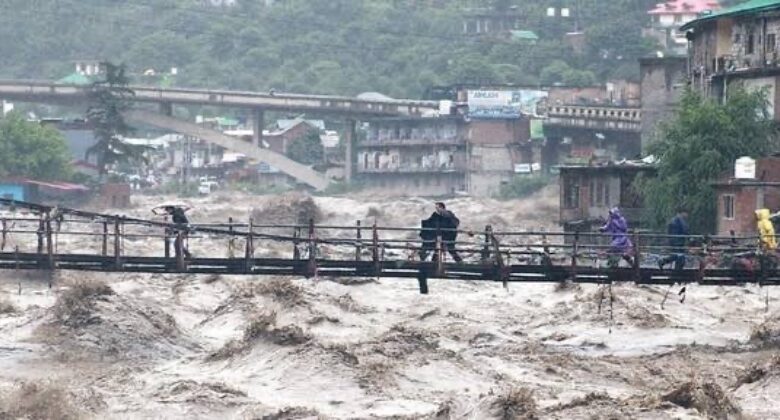Monsoon Mayhem In Uttarakhand And Himachal Pradesh
Climate change alters humidity, temperature pattern

The Indian Himalayas have been in mayhem ever since the arrival of Monsoon this year. The ongoing floods and devastation in the Himalayan states of Himachal Pradesh and Uttarakhand are proof of the increasing climate risks to an already vulnerable and fragile ecosystem. Scientists attribute rising temperatures to the increased atmospheric evaporation and humidity levels for the sudden extreme rains. The constant rise in land and sea temperatures have made the Himalayas vulnerable to torrential rain and its compound disasters, such as the economic losses being borne by both states along with the loss of lives and livelihoods. According to experts, weather conditions might have been favourable for heavy rains, but climate change has a definite role in the increasing intensity. According to the IPCC’s 6th Assessment Cycle Report, warming in the Himalayas has increased with altitude. Such elevation-dependent warming could lead to faster changes in the snowline, the glacier altitude and the snow/rain transition height (high confidence). This means the quantum of weather activities would undergo significant changes.
Increasing temperatures will continue to induce changes in mountain regions throughout the 21st century, with expected negative consequences for the mountain cryosphere, biodiversity, ecosystem services and human well-being, the IPCC claims this with “very high confidence”. Many low-elevation and small glaciers worldwide will lose most of their total snow mass at a 1.5°C global warming level. Most endemic mountain species will be at risk of extinction; regions heavily relying on glacier melt and snowmelt for irrigation will face erratic water supply and increased food insecurity, whereas agriculture in some areas might see positive changes. Damages and losses from water-related hazards such as floods and landslides are projected to increase considerably between 1.5°C and 3°C global warming levels.
During break-Monsoon conditions, most monsoon rainfall activities get focussed over Himalayan foothills and to an extent over Himachal Pradesh and Uttarakhand. At the same time, other parts of the country, like Central India, witness dry weather conditions. This is not new and has been happening ever since the existence of Monsoon. The science of global warming is clear that if we continue to emit more and more greenhouse gases into the atmosphere, especially CO2, it will enhance the air’s capacity to hold more and more water. Now, whenever favourable weather conditions appear, for example, in the case of break monsoon conditions, the air will release much more water vapour in the form of rainfall. This means the probability of an ordinary rainfall event intensifying into a heavy or extremely heavy one will increase because of global warming.
According to Mahesh Palawat, Vice President- Meteorology and Climate Change, Skymet Weather- “This is a typical pattern during the Monsoon season every year. At present, the country is witnessing break-Monsoon conditions. During this time, the axis of the Monsoon trough shifts northwards and stays stationed over the Himalayas triggering heavy to very heavy rains over the hilly region. However, a warming atmosphere has increased the intensity of rain tremendously. More warming means more energy in the environment, leading to more rain. Moisture availability is abundant in the atmosphere, which causes incidents like torrential rainfall in a short period causing damage like what we saw in Himachal and Uttarakhand this season,”
The rise in extreme weather events is unprecedented, and they have been multiplying rapidly. Monsoon 2023 is an apt reflection of what climate change impacts would do to the Himalayas if global warming goes unchecked. The atmosphere, land and oceans are all warming at a faster rate. The warmer it becomes, the more moisture the atmosphere can hold. This has led to more water being evaporated from the Earth’s surface. This increases the holding capacity of the air, which results in more droplets and heavier rainfall, sometimes in a shorter space of time and over a smaller area.
There has been an increase in the average relative humidity across India because of the rapid rise in land and sea temperatures. According to the Clausius-Clapeyron equation, the air can generally hold around 7% more moisture for every 1-degree Celsius temperature rise. Therefore, for relative humidity to stay the same under 1C of warming, the moisture content in the air also needs to increase by 7%. In theory, if there are no limiting factors, then this is the rate of increase we expect.
Experts say humidity is the prime factor behind the increasing likelihood of heavier rainfall and even more dangerous heat waves. Both humidity and temperature are the twin pillars of climate change.There has been a change in the western disturbance (WD) trajectory of late. WDs are more prevalent during winter when they travel in lower latitudes, bringing rain and snow over North India. During the summer, these systems tend to travel in higher latitudes and do not have much impact on the region during the ongoing season. However, active WDs have travelled across the Himalayas during the Monsoon season.
According to a recent study by the regional intergovernmental institute, The International Centre for Integrated Mountain Development (ICIMOD), the Hindu Kush Himalayas (HKH) cryosphere (glaciers, snow, permafrost) is undergoing unprecedented and largely irreversible changes over human timescales, primarily driven by climate change. The impacts are becoming increasingly clear, with increased warming at higher elevations, the accelerated melting of glaciers, increasing permafrost thaw, declining snow cover, and more erratic snowfall patterns. The “water towers” of the HKH, critical for downstream regions, are some of the most vulnerable to these changes in the world.
The writer of this article is Dr. Seema Javed, an environmentalist & a communications professional in the field of climate and energy




